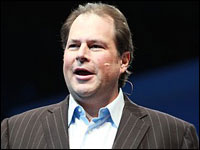
Salesforce came to New York this week for its annual winter meeting with customers. The company had two goals: test new ideas, and gather customer input.
The event was held at the Waldorf Astoria Hotel for a relatively small group — less than 1,000 — rather than at the Jacob Javits Convention Center, which can accommodate the maintenance facilities for a squadron of F18s. Intimacy, it was hoped, would drive better discussions.
Salesforce has been beating the social CRM drum pretty hard for the last two years. So right on schedule, Chairman and CEO Marc Benioff decided to reshuffle the deck. On Tuesday, Benioff introduced new messaging and a new prescription for companies wanting to get social.
Two years is about the shelf life of an idea like social for Salesforce. You only need to do a little archaeology to recall the changes over the company’s life span — from hosted to on-demand to SaaS to cloud computing to social — to see what I mean. Benioff, however, is not changing the message just for fun; there is a serious purpose behind it.
Social was a catch-all phrase designed to grab the attention of early adopters. By my research, that’s been very successful. Our data shows that executive decision makers in the enterprise and in smaller companies all understand that social is the next big thing. It will definitely reduce costs and boost revenues by a few points.
For enterprise class companies, that means real money. That’s a message that early adopters have received, and Salesforce has some great names to prove its point: General Electric, Toyota, Burberry’s and many others.
The Evolution of Social Business
The next step for a company in Salesforce’s position is to leverage the early success by now enlisting the early majority. That’s the next level of big companies that want to adopt new technology to capture some of the cost abatement and profits experienced by the early adopters.
The only hitch is that the early majority buyer typically wants more proof. Whereas the early adopter might have a C-level sponsor, the early majority will have a vice president or similar title making the charge. These people need proof, because they need to convince higher-ups that they should get some budget for the new gizmo.
Again, our research shows that the people in the early majority demographic are not sold yet. They might be leaning, but they also have questions: How do I do this? What are the security and legal ramifications? Which business processes are affected? And which ones should I start with?
Questions like these don’t get answered with social pixie dust, which is why the second iteration of the social message largely does away with social as a term, replacing it with the more concrete How to Become a Customer Company.
Now we’re cooking with gas. Becoming a more customer-centric company is an idea that’s been around in various permutations, and is readily digestible by the target audience because it offers a more concrete deliverable. In discussing what it means to be a customer company, you can’t pass go without checking in at better profits, lower costs and better customer retention.
I think Salesforce’s efforts for the rest of the year — through Dreamforce in December — will continue to flesh out what it means to be a customer company.
Commonsense Suggestions for Success
One of the failures of most social messaging so far has been its single-minded approach: Buy our product and your problems are over! Few people buy into that idea, but that’s where the market is at the moment. To his credit, Benioff has compiled a hefty list of things you can do — with or without his products, though they do make life easier — to get to customer nirvana.
In his New York presentation, Benioff unveiled a list of eight commonsense things you need to do to get to the new goal, including implementing technologies that enable a company to:
- Listen to every customer
- Engage on every channel
- Sell as a team
- Service customers everywhere
- Create communities
- Connect with partners
- Connect your products
- Deliver apps everywhere
Without going into elaborate detail on each, let me focus on connecting your products, which I believe will become the next big thing for social or customer companies.
You may have heard of this referred to by other phrases, such as the Internet of Things, and that’s apt. There is huge potential in providing a better overall customer experience by paying more attention to the things that customers buy, rather than bothering them all the time with former NYC mayor Ed Koch’s famous question: How am I doing?
If devices have relatively inexpensive sensors built into them that connect to the Internet and send a steady stream of performance data, then vendors will have the information they need and a legitimate reason for contacting customers.
A message such as “We think your engine will fail in a month or two” might not be what you want to hear. If this outreach, however, keeps you from being stranded or missing an important event, then with that message your vendor may successfully transition from an adversarial position of trying to sell you something else to a real partner in a relationship.
CRM bliss is made of such things.
To recap events at Salesforce in New York this week: New messaging, bigger ideas and pushing the ball forward to further improve the vendor-customer relationship, while offering the potential to reduce business friction and boost profits.

























































Actually, you don’t need sensors or any other technology embedded into the product. The idea that one must embed sensors into every product is not practical or economical. However, there is a way for products to become connected using existing smartphone technology. EVRYTHNG has developed a platform that provides every product with a digital identity. This means the "dumb" products can now be digitally connected; and companies can offer personalised experiences via these "smart" products.